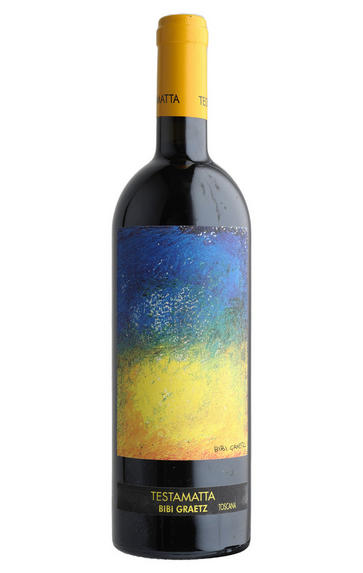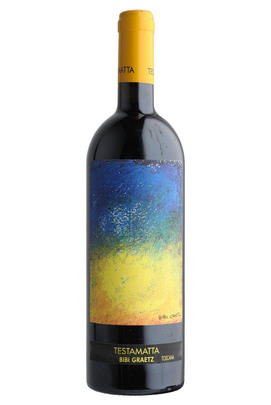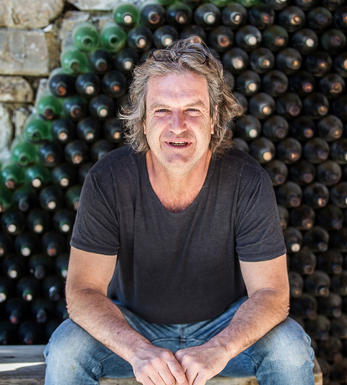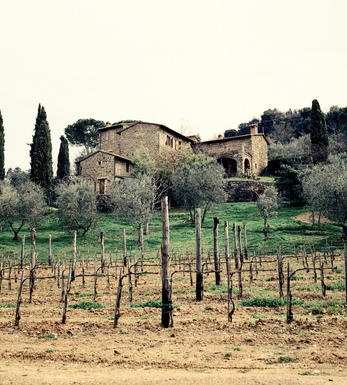
2020 Testamatta, Bibi Graetz, Tuscany, Italy

Critics reviews
Drink 2023 to 2035
Jane Anson, Inside Bordeaux (August 2022)
Bibi Graetz has long been tinkering with his formula for this wine, and this vintage represents a new chapter. The 2020 Testamatta is a blend of Sangiovese from old and new vines, with a priority on cooler growing conditions (and even a few northern exposures). In the wake of climate change, and in the pursuit of elegance, Bibi is changing his approach. He also has a new vineyard property near Fiesole, and the introduction of these grapes (from a breezy, high-elevation site) are what gives Testamatta its beautiful clarity, sharpness and lifted bouquet. The new Fiesole fruit makes up about 30% to 35% of this wine. The results are vibrant, transparent and fresh both in terms of acidity and aromatic intensity. This is a wine in transformation and a wine to watch.
Drink 2023 - 2043
Monica Larner, Wine Advocate (Jun 2022)
Beautiful, fresh aromas of sour cherries, orange peel and lemon bush. Medium-bodied with firm, racy acidity and ultra-fine tannins that add brightness and energy to the wine. This is definitely following the new wave of crunchy, vivid Tuscany sangioveses, which emphasize drinkability and transparency. Lighter than past vintages. Drink now or hold.
James Suckling, jamessuckling.com (Jul 2022)
Wild roses and wild strawberries, the nose has a lovely fragrance and expression. Lifted and bright, this has such a beautiful delicacy to it, a creamy, chalkiness comes from the fine tannins with bright, succulent strawberry and raspberry leaf elements. You feel the savoury side too, the sweet vanilla spice and dried herb aspect which counter the fruit and the high acidity. I adore the finesse here, the sharp fruit giving the energy and the chalky texture giving the layers. Feels well controlled, powerful yet delivered with poise. It doesn't have so much overt weight, it's definitely more ethereal in terms of density, but the nuance of flavour is thrillingly captivating and this has a long lifted finish. A contemplative wine that keeps you wanting more and more. Made in new winery facilities in Fiesole. Grapes were picked from the best six vineyards; Vincigliata, Olmo, Londa, Lamole, Montefili and Siena with each divided into parcels and harvested up to eight times to get the perfect ripening points. Natural and indigenous fermentation in open top barriques (225l) for smaller parcels and 50hl cask or stainless steel tanks for larger plots. After 7-10 days of maceration, the parcels are moved into old barriques and 50hl casks for 20 months.
Drink 2025 - 2045
Georgina Hindle, Decanter.com (Aug 2022)
About this WINE

Bibi Graetz
Bibi Graetz founded his eponymous Tuscan winery in 2000. Born in Florence, Bibi comes from a family of artists. Bibi himself studied art before pursuing wine as a full-time endeavour. He still paints sometimes, notably for the striking labels of his wines including Colore and Testamatta. The operation is based out of a disused hotel, the Aurora, in the town of Fiesole which lies in the hills above Florence.
Working with his own estate vineyards as well as fruit sourced from other growers, Bibi describes his model as “Californian”. His white wines Colore Bianco and Testamatta Bianco come from fruit grown on the island of Giglio, around eight miles from the Tuscan coast. Both wines are produced from the Ansonica grape; the island is home to a stock of old vines, some up to 100 years old.
For his reds, he works with 100% Sangiovese fruit from a selection of vineyards in the hilly area best known for Chianti – though Bibi uses the Toscana IGT designation for his wines. Colore is now produced exclusively from old vines, at least 80 years old for the 2021 vintage. Bibi now makes Testamatta only from north-facing slopes.

IGT Tuscany
IGT (Indicazione Geografica Tipica) Tuscany is a wine classification from Italy's Tuscany region. It is one of the official wine classifications recognized by the Italian government. IGT is a step below the highest classification, DOCG (Denominazione di Origine Controllata e Garantita), and above the DOC (Denominazione di Origine Controllata) level.
The IGT classification was introduced in 1992 to allow winemakers more flexibility in grape varieties and employ winemaking techniques while still ensuring a certain level of quality and geographical indication. This classification gives winemakers more freedom to experiment and innovate, deviating from the strict regulations of the DOC and DOCG classifications.
IGT Tuscany wines can be produced throughout the entire region of Tuscany, encompassing various sub-regions and terroirs within the area. This classification allows winemakers to use traditional Tuscan grape varieties, such as Sangiovese, and non-traditional grape varieties, including international ones like Cabernet Sauvignon, Merlot, Syrah, and others.
The IGT Tuscany classification gives winemakers the flexibility to create wines that showcase the unique characteristics of their specific vineyards and winemaking styles. It allows for experimentation with blending different grape varieties, using innovative winemaking techniques, and exploring new regional vineyard sites.
IGT Tuscany wines can vary greatly, from traditional and terroir-driven expressions to more modern and international styles. This classification has played a significant role in developing Super Tuscan wines, often IGT designated and known for their high quality and international recognition.
Overall, IGT Tuscany provides a platform for winemakers in the region to express their creativity and produce wines that reflect their unique vision while maintaining a connection to the rich heritage and traditions of winemaking in Tuscany.

Sangiovese
A black grape widely grown in Central Italy and the main component of Chianti and Vino Nobile di Montepulciano as well as being the sole permitted grape for the famed Brunello di Montalcino.
It is a high yielding, late ripening grape that performs best on well-drained calcareous soils on south-facing hillsides. For years it was blighted by poor clonal selection and massive overcropping - however since the 1980s the quality of Sangiovese-based wines has rocketed upwards and they are now some of the most sought after in the world.
It produces wines with pronounced tannins and acidity, though not always with great depth of colour, and its character can vary from farmyard/leather nuances through to essence of red cherries and plums. In the 1960s the advent of Super Tuscans saw bottlings of 100% Sangiovese wines, as well as the introduction of Sangiovese/Cabernet Sauvignon blends, the most famous being Tignanello.


Buying options
Add to wishlist
Description
Gloriously jewel-like in colour, understated joyful frame flowing with juicy black cherry, raspberry, mandarin peel, fresh acidities and bounce. Everything feels in high definition, continuing the evolution of Testamatta from its earliest years. Softly brushed tannins that are barely there, extremely easy to recommend, you are going to want to share this wine. Harvest September 24 to October 25, taking things slowly. From a range of plots set at 400m to 600m altitude across Tuscany, with vines that head up to 80 years old. Natural yeasts, manual punch downs, 10 days maceration and barrel ageing with no new oak.
Drink 2023 to 2035
Jane Anson, Inside Bordeaux (August 2022)
wine at a glance
Delivery and quality guarantee